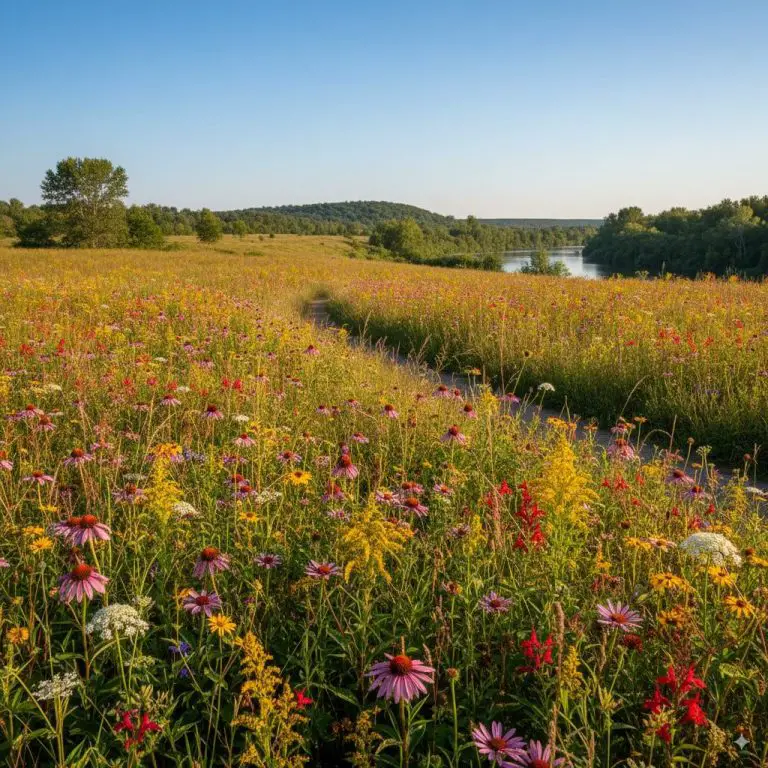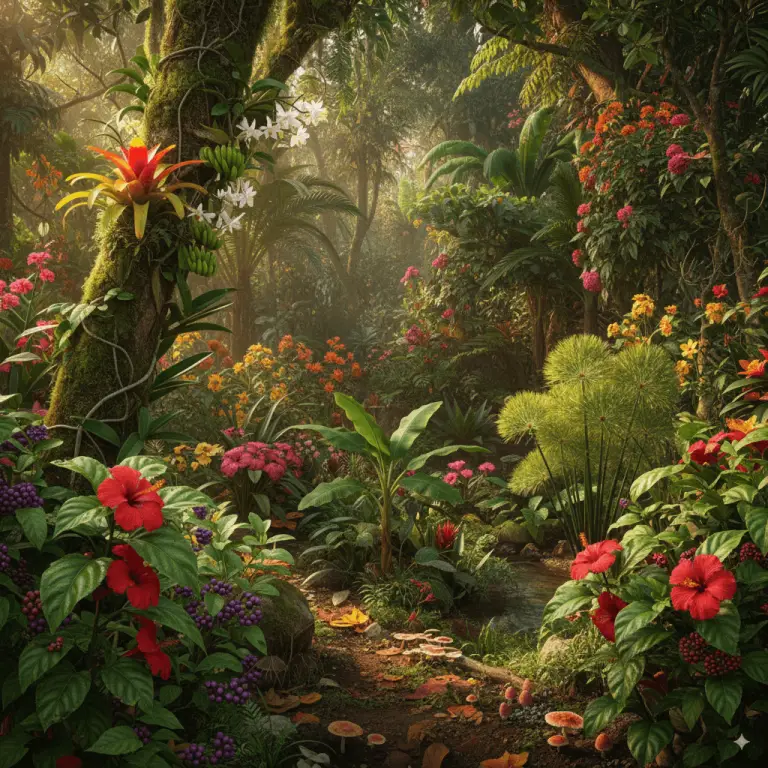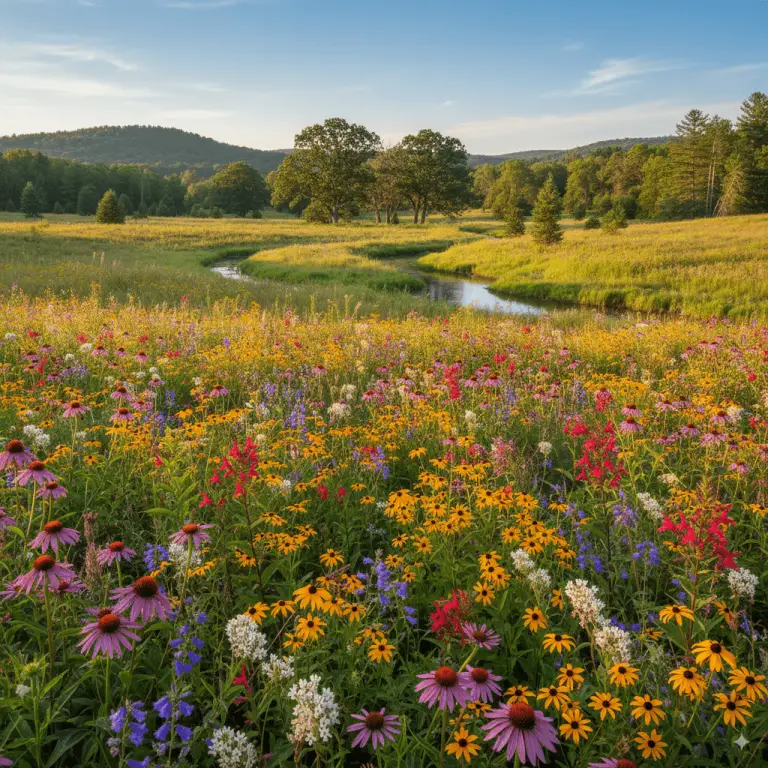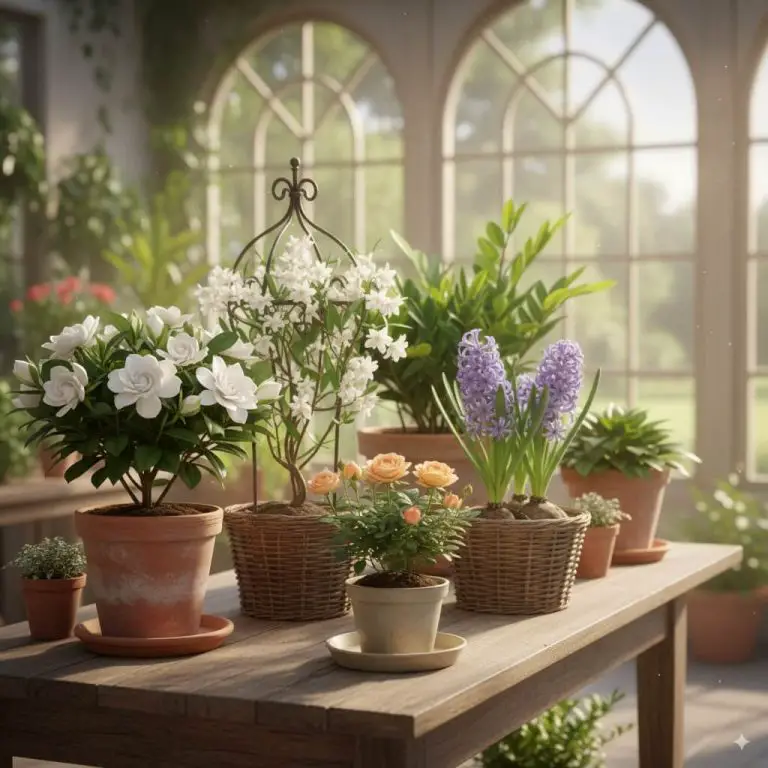Fall Flowering Plants – A Gardener’S Guide To Rich Color & Late-Season
As the long, sun-drenched days of summer begin to shorten, do you ever look at your garden and feel a little wistful? It’s a common feeling among gardeners—that sense that the season’s grand finale is over and all that’s left is a slow fade to brown.
But I’m here to promise you something exciting: your garden’s most breathtaking show might just be ahead. The end of summer doesn’t mean the end of color. In fact, with the right strategy, your autumn garden can be the most vibrant, rich, and lively it’s been all year.
In this complete fall flowering plants guide, we’re going to walk through everything you need to turn your yard into an autumn masterpiece. We’ll explore the absolute best bloomers for the season, share essential care tips to ensure they thrive, and even cover sustainable practices that will keep your garden buzzing with life right up until the first frost. Let’s get growing!
What's On the Page
- 1 Why Your Garden Desperately Needs Fall Flowering Plants
- 2 Our Top 10 Must-Have Fall Flowering Plants for Stunning Color
- 3 A Complete Fall Flowering Plants Care Guide: From Planting to Frost
- 4 Sustainable & Eco-Friendly Fall Gardening Practices
- 5 Solving Common Problems with Fall Flowering Plants
- 6 Frequently Asked Questions About Fall Flowering Plants
- 7 Your Most Colorful Autumn Awaits
Why Your Garden Desperately Needs Fall Flowering Plants
Think of fall flowers as the encore to your summer garden performance. They do more than just look pretty; they play a vital role in the health and beauty of your entire outdoor space. Understanding the benefits of fall flowering plants is the first step to becoming a true four-season gardener.
First and foremost, they provide a critical late-season food source for pollinators. As other flowers fade, honeybees, bumblebees, and migrating monarch butterflies are still desperately searching for nectar to fuel their journeys or prepare for winter. Planting fall bloomers is one of the most impactful things you can do for your local ecosystem.

🌿 The Companion Planting & Gardening Book (eBook)
Bigger harvests, fewer pests — natural pairings & simple layouts. $6.99
Get – $6.99
🪴 The Pest-Free Indoor Garden (eBook)
DIY sprays & soil tips for bug-free houseplants. $4.89
Get – $4.99Beyond the environmental perks, these plants offer a stunning visual transition. They trade the bright pinks and electric blues of summer for a sophisticated palette of deep golds, rich burgundies, royal purples, and fiery oranges. This splash of color provides a beautiful contrast to the changing leaves, creating a landscape full of depth and texture.
Finally, they extend your own enjoyment of the garden. Those crisp, sunny autumn afternoons are perfect for sitting outside with a warm drink, and having a garden bursting with life makes that experience infinitely more rewarding.
Our Top 10 Must-Have Fall Flowering Plants for Stunning Color
Ready to add some autumn superstars to your garden? Here is a curated list of reliable, beautiful, and hard-working plants that will deliver a spectacular fall show. I’ve grown every one of these in my own garden, and they never disappoint!
1. Aster (Symphyotrichum)
Asters are the undisputed queens of the fall garden. These daisy-like perennials explode into a cloud of purple, blue, pink, or white flowers. They are absolute magnets for bees and butterflies.
Sun/Soil: Full sun is best for sturdy stems and maximum blooms. They prefer well-drained soil.
Pro Tip: Pinch back the stems by about one-third in late spring (around June) to encourage bushier growth and prevent the plants from getting leggy and flopping over in the fall.
2. Chrysanthemum (Chrysanthemum)
You can’t talk about fall without mentioning mums! While the potted mums at the grocery store are great for temporary color, planting hardy perennial mums will give you a reliable show year after year. They come in nearly every color imaginable.
Sun/Soil: Full sun and rich, well-drained soil.
Pro Tip: Just like asters, mums benefit from being pinched back a few times before early July. This creates a compact, dome-shaped plant that will be absolutely covered in flowers.
3. Sedum ‘Autumn Joy’ (Hylotelephium telephium)
If you want a plant that is practically foolproof, this is it. ‘Autumn Joy’ starts as pale green broccoli-like heads in summer, which slowly transform to dusty pink and finally a deep, coppery red in the fall. Don’t worry—these flowers are perfect for beginners!
Sun/Soil: Thrives in full sun and is very tolerant of poor, dry soil. It hates wet feet!
Pro Tip: Leave the dried seed heads standing through winter. They look gorgeous dusted with snow and provide food for birds.
4. Goldenrod (Solidago)
Forget the myth—goldenrod does not cause hay fever (that’s ragweed!). This native powerhouse produces brilliant plumes of golden-yellow flowers that support over 100 different species of bees and butterflies. It’s a cornerstone of an eco-friendly fall garden.
Sun/Soil: Full sun to light shade. Tolerant of a wide range of soils.
Pro Tip: Choose a well-behaved cultivar like ‘Fireworks’ or ‘Golden Fleece’ to prevent it from spreading too aggressively in a smaller garden bed.
5. Japanese Anemone (Anemone hupehensis)
For a touch of elegance, look no further. Delicate, poppy-like flowers in shades of white and pink dance on tall, wiry stems, bringing graceful movement to the garden. They are a beautiful, sophisticated addition.
Sun/Soil: They prefer part-sun or morning sun with afternoon shade, especially in hotter climates. They love rich, moist soil.
Pro Tip: Anemones can be slow to establish and don’t like to be moved. Be patient with them the first year; the reward is well worth it.
6. Joe Pye Weed (Eutrochium purpureum)
Want some drama? Joe Pye Weed is a tall, stately native perennial that produces huge, fuzzy heads of mauve-pink flowers. It creates a stunning backdrop for other fall bloomers and is a favorite of large butterflies.
Sun/Soil: Full sun to part shade. It loves consistently moist soil.
Pro Tip: Don’t be afraid to cut it back by half in early summer if you want a shorter, more compact plant. It will still bloom beautifully.
7. Pansy & Viola (Viola x wittrockiana)
These cheerful annuals are perfect for containers, window boxes, and front-of-the-border color. They can handle a light frost, often blooming well into early winter in milder climates and even reappearing in spring.
Sun/Soil: Full sun to part shade with moist, well-drained soil.
Pro Tip: For the best performance, plant them in the fall once nighttime temperatures are consistently cool. They establish much better than in the heat of late summer.
8. Helenium (Sneezeweed)
Don’t let the name fool you! Helenium is a fantastic perennial that provides a blast of warm, autumnal color. Its daisy-like flowers come in shades of gold, burnt orange, and deep red, perfectly echoing the fall foliage.
Sun/Soil: Needs full sun to thrive. Prefers soil that stays evenly moist.
Pro Tip: Deadhead spent flowers regularly to encourage continuous blooming straight through to the first hard frost.
9. Toad Lily (Tricyrtis)
For the shady corners of your garden, the Toad Lily is a true gem. It produces small, intricate, orchid-like flowers, often speckled with purple. It’s a unique plant that always gets attention.
Sun/Soil: Thrives in part to full shade with rich, consistently moist soil.
Pro Tip: Plant them near a path or patio where you can appreciate their detailed, exotic blooms up close.
10. Celosia (Cockscomb)
Looking for incredible texture? Celosia’s velvety plumes and crested flowers in jewel tones of red, magenta, and gold are showstoppers. While an annual, it makes a huge impact in a single season.
Sun/Soil: Full sun and well-drained soil are a must. They are quite drought-tolerant once established.
Pro Tip: Celosia makes an excellent dried flower. Cut the stems before they go to seed and hang them upside down in a dark, dry place.
A Complete Fall Flowering Plants Care Guide: From Planting to Frost
Knowing how to fall flowering plants should be cared for is just as important as choosing the right ones. Follow these best practices to ensure your autumn garden is healthy and vibrant. This is your go-to fall flowering plants care guide.
Planting & Timing
The secret to great fall perennials is planting them well before fall! Aim to get perennials like Asters, Sedum, and Goldenrod in the ground in the spring or early summer. This gives their root systems a full season to get established before they have to focus their energy on blooming.
For fall annuals like pansies and mums meant for seasonal display, you can plant them in late summer or early fall as soon as they become available at your local garden center.
Watering Wisely
Autumn can be surprisingly dry. While the days are cooler, plants are still actively growing and blooming, and they need consistent moisture. Check the soil every few days by sticking your finger in about an inch deep. If it’s dry, it’s time to water.
Water deeply at the base of the plant, avoiding the foliage. This helps prevent common fungal diseases like powdery mildew.
Feeding for Fall Blooms
If you’ve been fertilizing your plants all summer, you can generally ease up in the fall. A final dose of a balanced, low-nitrogen fertilizer (like one with a 5-10-10 ratio) in late summer can help promote strong blooms without encouraging a lot of tender new leafy growth that will just be zapped by the first frost.
Sustainable & Eco-Friendly Fall Gardening Practices
A beautiful garden can also be a healthy one for the planet. Adopting sustainable fall flowering plants and gardening habits is easy and makes a huge difference. Here are a few of my favorite eco-friendly tips.
Choose Native Plants
Whenever possible, incorporate native plants like Goldenrod, Asters, and Joe Pye Weed. They are adapted to your local climate, require less water and fertilizer, and are the absolute best food source for local pollinators and wildlife.
Leave the Leaves!
Don’t rush to rake up all your fallen leaves. A layer of shredded leaves on your garden beds acts as a free, natural mulch. It suppresses weeds, retains moisture, and slowly breaks down to enrich the soil. It also provides a critical habitat for overwintering insects.
Resist the Urge for a “Tidy” Cleanup
This is one of the most important fall flowering plants tips I can give. Leave the stalks and seed heads of your perennials standing through the winter. Birds like finches and juncos will feast on the seeds, and beneficial insects will lay their eggs or hibernate inside the hollow stems. You can clean it all up in early spring.
Solving Common Problems with Fall Flowering Plants
Even the best gardeners run into issues. Here’s a quick troubleshooting guide for some common problems with fall flowering plants.
Problem: Powdery Mildew
You might see a white, dusty coating on the leaves of plants like mums or asters, especially during humid fall weather.
- Solution: Improve air circulation by giving plants enough space. Water at the base, not overhead. For minor cases, you can spray with a solution of one tablespoon of baking soda and a half-teaspoon of liquid soap in a gallon of water.
Problem: Leggy, Floppy Stems
This is when tall plants like asters or sedum flop over from the center, looking messy.
- Solution: This is usually caused by too much shade, too much fertilizer, or a lack of pinching earlier in the season. Make a note for next year to pinch them back in June. For a quick fix now, you can use garden stakes or peony rings to prop them up.
Problem: Early Frost Damage
An unexpected early frost can threaten to end the show prematurely.
- Solution: Keep an eye on the weather forecast. If a light frost is predicted, cover your most tender plants (especially annuals) overnight with an old bedsheet or frost cloth. Remove it in the morning so they can get sunlight.
Frequently Asked Questions About Fall Flowering Plants
What are the easiest fall flowering plants for beginners?
For gardeners just starting out, I highly recommend Sedum ‘Autumn Joy’, Asters, and Pansies. They are all incredibly forgiving, widely available, and provide a huge color payoff with minimal fuss.
Can I plant fall flowers in containers?
Absolutely! Containers are a fantastic way to add a pop of fall color to your porch, patio, or balcony. Chrysanthemums, pansies, ornamental cabbage and kale, celosia, and some smaller varieties of asters do wonderfully in pots.
When should I plant my fall perennials?
The ideal time to plant most fall-blooming perennials is in the spring. This gives them many months to develop a strong root system before they need to put energy into flowering. Planting in fall is possible, but they may not be as robust in their first year.
How do I prepare my fall flowering plants for winter?
After the ground freezes, add a 2-3 inch layer of mulch (like shredded leaves or bark) around the base of your perennials to insulate their roots. As mentioned before, resist cutting them back until spring to provide food and shelter for winter wildlife.
Your Most Colorful Autumn Awaits
Your garden’s story doesn’t have to end with the last days of summer. By embracing the unique beauty of autumn, you can create a landscape that is just as vibrant and full of life as it was in June.
Think of the deep purples of an aster, the rich gold of a goldenrod, and the warm glow of a sedum in the late afternoon sun. These are the colors that make a garden feel truly complete.
So grab a trowel, pick a few of these autumn beauties, and get ready to create your most spectacular fall display yet. Happy gardening!
- When To Cut Back Cucumber Plants – Your Ultimate Guide For A Bountiful - November 7, 2025
- Cucumber Plant Diseases Treatment – Your Guide To Spotting And - November 7, 2025
- Can You Cut Back Cucumber Plants – A Gardener’S Pruning Guide For - November 7, 2025




